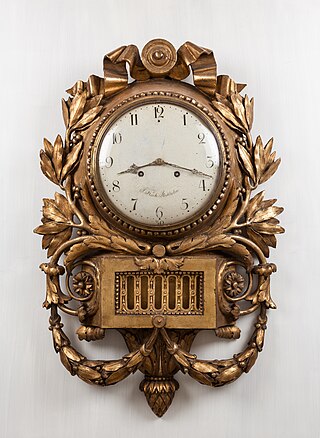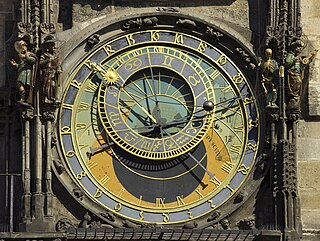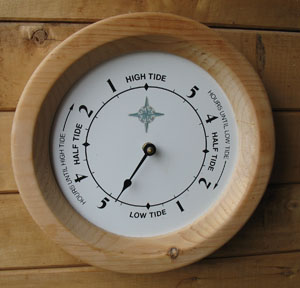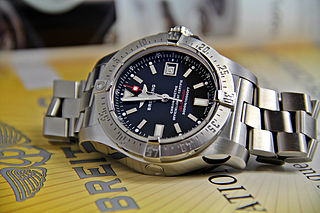
A clock or chronometer is a device that measures and displays time. The clock is one of the oldest human inventions, meeting the need to measure intervals of time shorter than the natural units such as the day, the lunar month, and the year. Devices operating on several physical processes have been used over the millennia.

A watch is a portable timepiece intended to be carried or worn by a person. It is designed to keep a consistent movement despite the motions caused by the person's activities. A wristwatch is designed to be worn around the wrist, attached by a watch strap or other type of bracelet, including metal bands, leather straps, or any other kind of bracelet. A pocket watch is designed for a person to carry in a pocket, often attached to a chain.

A sundial is a horological device that tells the time of day when direct sunlight shines by the apparent position of the Sun in the sky. In the narrowest sense of the word, it consists of a flat plate and a gnomon, which casts a shadow onto the dial. As the Sun appears to move through the sky, the shadow aligns with different hour-lines, which are marked on the dial to indicate the time of day. The style is the time-telling edge of the gnomon, though a single point or nodus may be used. The gnomon casts a broad shadow; the shadow of the style shows the time. The gnomon may be a rod, wire, or elaborately decorated metal casting. The style must be parallel to the axis of the Earth's rotation for the sundial to be accurate throughout the year. The style's angle from horizontal is equal to the sundial's geographical latitude.
The 12-hour clock is a time convention in which the 24 hours of the day are divided into two periods: a.m. and p.m.. Each period consists of 12 hours numbered: 12, 1, 2, 3, 4, 5, 6, 7, 8, 9, 10 and 11. The 12-hour clock has been developed since the second millennium BC and reached its modern form in the 16th century.

A clock face is the part of an analog clock that displays time through the use of a flat dial with reference marks, and revolving pointers turning on concentric shafts at the center, called hands. In its most basic, globally recognized form, the periphery of the dial is numbered 1 through 12 indicating the hours in a 12-hour cycle, and a short hour hand makes two revolutions in a day. A long minute hand makes one revolution every hour. The face may also include a second hand, which makes one revolution per minute. The term is less commonly used for the time display on digital clocks and watches.

A pocket watch is a watch that is made to be carried in a pocket, as opposed to a wristwatch, which is strapped to the wrist.

Seiko Group Corporation, commonly known as Seiko, is a Japanese maker of watches, clocks, electronic devices, semiconductors, jewelry, and optical products. Founded in 1881 by Kintarō Hattori in Tokyo, Seiko introduced the world's first commercial quartz wristwatch in 1969.

An astronomical clock, horologium, or orloj is a clock with special mechanisms and dials to display astronomical information, such as the relative positions of the Sun, Moon, zodiacal constellations, and sometimes major planets.

TAG Heuer S.A., founded Heuer AG is a Swiss luxury watchmaker. Founded in 1860 by Edouard Heuer in St-Imier, Switzerland, it was acquired by Techniques d'Avant Garde in 1985, which purchased a majority stake in the company, forming TAG Heuer. In 1999, French luxury goods conglomerate LVMH bought nearly 100 percent of the Swiss company. The name TAG Heuer combines the initials of "Techniques d'Avant Garde" and the founder's surname.

A chronograph is a specific type of watch that is used as a stopwatch combined with a display watch. A basic chronograph has an independent sweep second hand and a minute sub-dial; it can be started, stopped, and returned to zero by successive pressure on the stem. More complex chronographs use additional complications and can have multiple sub-dials to measure seconds, minutes, hours and even fractions of a second. In addition, many modern chronographs use moveable bezels as tachymeters for rapid calculations of speed or distance. Louis Moinet invented the chronograph in 1816 for use in tracking astronomical objects. Chronographs were also used heavily in artillery fire in the mid to late 1800s. More modern uses of chronographs involve aircraft piloting, auto racing, diving and submarine maneuvering.

A world clock is a clock which displays the time for various cities around the world. The display can take various forms:

A digital clock displays the time digitally, as opposed to an analogue clock.

A tide clock is a specially designed clock that keeps track of the Moon's apparent motion around the Earth. Along many coastlines, the Moon contributes the major part (67%) of the combined lunar and solar tides. The exact interval between tides is influenced by the position of the Moon and Sun relative to the Earth, as well as the specific location on Earth where the tide is being measured. Due to the Moon's orbital prograde motion, it takes a particular point on the Earth 24 hours and 50.5 minutes to rotate under the Moon, so the time between high lunar tides fluctuates between 12 and 13 hours. A tide clock is divided into two roughly 6 hour tidal periods that shows the average length of time between high and low tides in a semi-diurnal tide region, such as most areas of the Atlantic Ocean.

Clocks and watches with a 24-hour analog dial have an hour hand that makes one complete revolution, 360°, in a day. The more familiar 12-hour analog dial has an hour hand that makes two complete revolutions in a day.

A diving watch, also commonly referred to as a diver's or dive watch, is a watch designed for underwater diving that features, as a minimum, a water resistance greater than 1.1 MPa (11 atm), the equivalent of 100 m (330 ft). The typical diver's watch will have a water resistance of around 200 to 300 m, though modern technology allows the creation of diving watches that can go much deeper. A true contemporary diver's watch is in accordance with the ISO 6425 standard, which defines test standards and features for watches suitable for diving with underwater breathing apparatus in depths of 100 m (330 ft) or more. Watches conforming to ISO 6425 are marked with the word DIVER'S to distinguish ISO 6425 conformant diving watches from watches that might not be suitable for actual scuba diving.

A mechanical watch is a watch that uses a clockwork mechanism to measure the passage of time, as opposed to quartz watches which function using the vibration modes of a piezoelectric quartz tuning fork, or radio watches, which are quartz watches synchronized to an atomic clock via radio waves. A mechanical watch is driven by a mainspring which must be wound either periodically by hand or via a self-winding mechanism. Its force is transmitted through a series of gears to power the balance wheel, a weighted wheel which oscillates back and forth at a constant rate. A device called an escapement releases the watch's wheels to move forward a small amount with each swing of the balance wheel, moving the watch's hands forward at a constant rate. The escapement is what makes the 'ticking' sound which is heard in an operating mechanical watch. Mechanical watches evolved in Europe in the 17th century from spring powered clocks, which appeared in the 15th century.
Greubel Forsey is a Swiss watchmaking company specializing in complicated, high-end timepieces. It was launched in 2004 by Robert Greubel and Stephen Forsey and is based in La Chaux-de-Fonds, Switzerland.

A clock position, or clock bearing, is the direction of an object observed from a vehicle, typically a vessel or an aircraft, relative to the orientation of the vehicle to the observer. The vehicle must be considered to have a front, a back, a left side and a right side. These quarters may have specialized names, such as bow and stern for a vessel, or nose and tail for an aircraft. The observer then measures or observes the angle made by the intersection of the line of sight to the longitudinal axis, the dimension of length, of the vessel, using the clock analogy.

RESSENCE is a watch manufacturer founded in 2010 by Benoît Mintiens in Antwerp, Belgium. The brand name is a portmanteau of "Renaissance" and "essence".
Direction determination refers to the ways in which a cardinal direction or compass point can be determined in navigation and wayfinding. The most direct method is using a compass, but indirect methods exist, based on the Sun path, the stars, and satellite navigation.


















